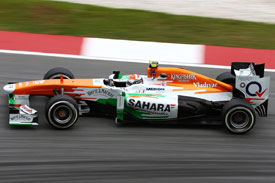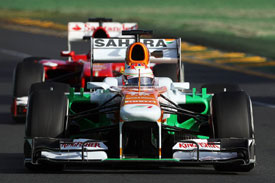| By Edd Straw | Tuesday, April 2nd 2013, 10:22 GMT |
 Force India deputy team principal Bob Fernley has warned engines must not become the overwhelming performance differentiator when the new Formula 1 regulations kick in next year.
Force India deputy team principal Bob Fernley has warned engines must not become the overwhelming performance differentiator when the new Formula 1 regulations kick in next year.
In 2014 F1 will switch to 1.6-litre turbocharged V6 powerplants, with Force India continuing to use engines supplied by Mercedes.
But with the spread of performance relatively tight in recent years, during which the FIA has had a policy of occasionally allowing manufacturers to make changes to their frozen-specification engines for performance reasons, Fernley says the sport must ensure this relative parity is not lost.
"Yes, it is," Fernley told AUTOSPORT when asked if it is important for F1 to maintain this equilibrium of engines.
"It mustn't be like it was in the past when the engine differentiators were overwhelming. It would be a shame if we got there."
Force India has thrived under the current regulations, climbing from the bottom of the constructors' championship to be an ever-present in the top seven in the standings during the past three years.
But despite being keen that engines do not become too big a performance differentiator, Fernley accepts that it is important for the manufacturers to be allowed to play a bigger part in what happens on track.
"We have to take into consideration what the engine manufacturers want to do," he said.
 "They are sinking an awful lot of money into the development of these engines and we have to listen to them to.
"They are sinking an awful lot of money into the development of these engines and we have to listen to them to.
"There's a bit more scope than we have now, but overall it [engine performance] shouldn't be too big a differentiator."
Discussions are ongoing as to how engine homologation will be approached in F1 from 2014, with the sporting regulations yet to be published.
While the principle of having some form of homologation is accepted, the exact form that it will take is yet to be finalised.
AUTOSPORT SAYS
F1 editor Edd Straw
F1's engine freeze, combined with the reduction in costs of supply deals for customer teams, has created a level playing field in F1 that has made it easier for medium and small teams to compete.
There was a time when smaller teams would run engines that were a step, or multiple steps, behind the works operations. In some cases, minnows would even run at a bhp-deficit measured in three figures.
Under those circumstances, it was impossible for them to be anything other than back-of-the-grid fodder irrespective of how good their cars were.
 This limited the benefit of even having a good car, hence the feeling that some outfits were simply treading water rather than seriously going racing.
This limited the benefit of even having a good car, hence the feeling that some outfits were simply treading water rather than seriously going racing.
There's no doubt that the 2014 season will be all about engine performance and it's unlikely that Ferrari, Renault and Mercedes will all come out with units that are as evenly-matched on performance as the long-in-the-tooth 2.4-litre V8s are.
While the performance of engines - or "power units" as they should more correctly but less intuitively be called given the green technology that is included - will be equal across those using the same manufacturer, there is a risk that one or two groups of teams will be at a major disadvantage.
What the sport must avoid is a situation where teams, some of which are already dancing around the edge of a financial precipice, have no chance thanks to the misfortune of choosing the 'wrong' engine supplier and have that weakness locked in by homologation rules.
Anda sedang membaca artikel tentang
Force India: V6s must not dictate form
Dengan url
http://pusingkepalawa.blogspot.com/2013/04/force-india-v6s-must-not-dictate-form.html
Anda boleh menyebar luaskannya atau mengcopy paste-nya
Force India: V6s must not dictate form
namun jangan lupa untuk meletakkan link
Force India: V6s must not dictate form
sebagai sumbernya
0 komentar:
Posting Komentar